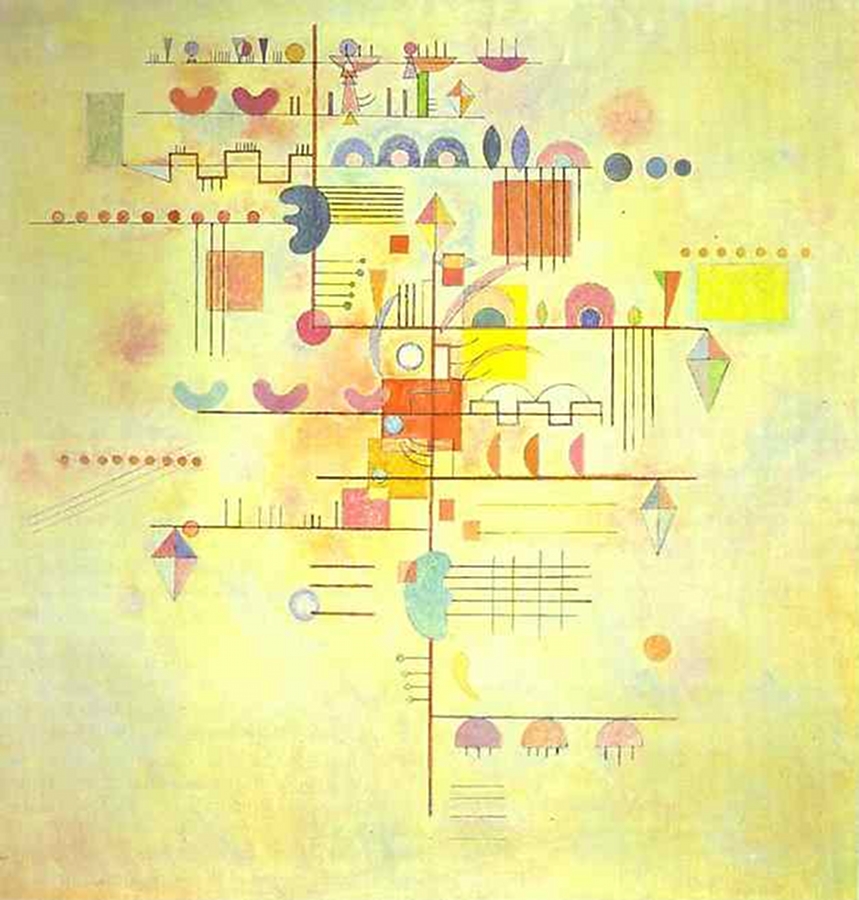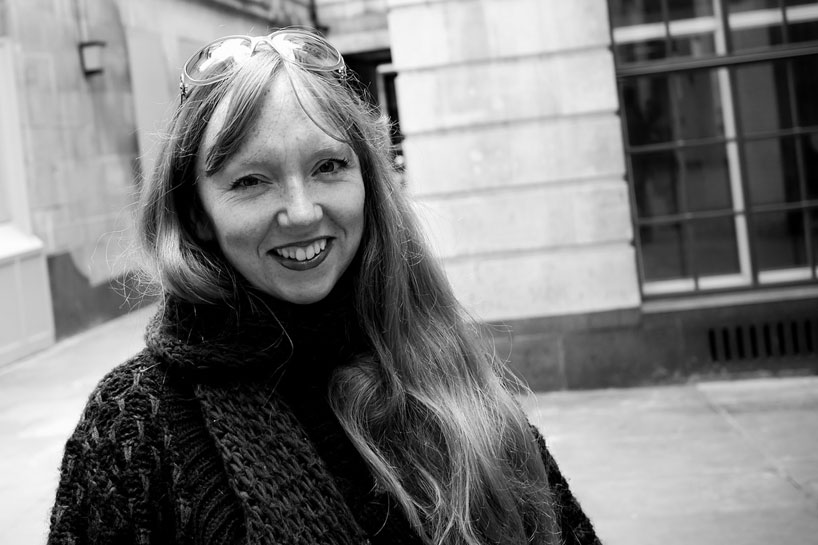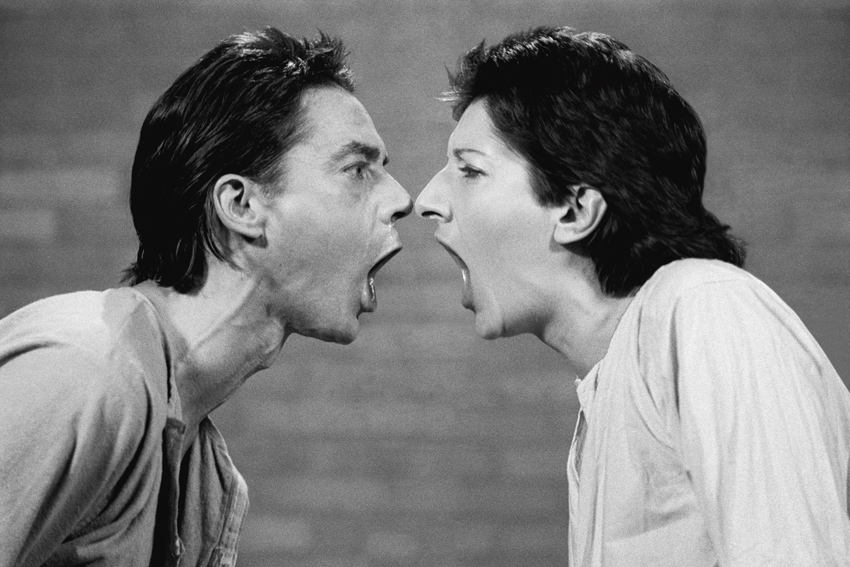The role of sound in visual arts
At the turn of this century artists bumped into each art’s borders that we cannot cross at least because of the limitations of our senses. Vision and hearing are separated by an insurmountable barrier in classical art. Still, visual and sound information is read and processed by our brain – and much in the same way. For example, binocular vision enables us to comparatively assess distances and determine volumes as information from our left and right eyes is added up and summarised. Similarly, summarised is the information coming from our right and left ears, which permits sound direction finding (though very weak as compared to some animals’).
Artists have repeatedly probed into this barrier, trying to awaken our mind’s eye and inner ear to art. This was first done by symbolists, who tried to convince visitors of art shows and musical concerts that colours did resound (the Yellow Sound play by Wassily Kandinsky) and that symphony poems could be transposed onto the canvas just in the same way as Lithuanian artist Čiurlionis did.
Those ideas of the artistic and subjective portrayal of sound have become commonplace now. They have even penetrated into kindergartens where boys and girls are asked to draw the music they hear. It seems to be tacitly understood that no adult will do this. The resulting works are too subjective and hard to distinguish from ordinary expressive abstractions.

The Yellow Sound play by Wassily Kandinsky
Futurists and scientists – music 2.0
Then the Futurists took to music in art. They invented ‘noise music’ or ‘action music’ and linked it to visual art; it’s no coincidence that Luigi Russolo, inventor of L’arte dei Rumori , had practised as a painter before his experiments with sound. And, incidentally, returned to painting after his experimentation period was over. City sounds and car noises came not only into object music but, more broadly, into art in general as one of the colours in its palette, to portray the world around us more objectively. Instead of looking at colour combinations in a landscape in search of musical phrases, noise music wanted us to see a cityscape using its sound reference points.
Artistic-minded scientists and engineers began inventing special electro-acoustic instruments to convert motion into sound. A person would move in electromagnetic field and his motions would produce sounds. One could learn to move so as to play harmonic music, or one could produce inspired dissonances. Machines like the Thereminvox from Léon Theremin were thus the precursors of modern installation machines. As was the Optophone piano invented by Vladimir Baranoff-Rossine – one that produced colour projections as well as sounds as its keys were pressed..
The role of sound in cinema
But the heaviest sound invasion into art occurred in the cinema, of course. That was commercial and on a massive scale; the stage of artistic experiments was passed instantly if at all. After the first timid and funny experiments, motion pictures began starring sound. Walt Disney’s Fantasia was a farewell to silent films, but a very good-humoured one, with a symbolist portrayal of music by Schubert, Debussy, Mussorgsky, Stravinsky and Tchaikovsky,. In our times, soundless cinema looks an exception and an artistic experiment but can still take multiple Oscars, like the French film The Artist did earlier this year.
Impact of sound as a creative tool
Two years ago, one of the main prizes addressed to modern visual artists, the Turner Prize, went to Susan Philipsz whose sound installation was actually a replay of 17th-century Scottish folk songs. The place of sound in modern art was thus officially marked. Modern artists cannot use sound; as we have already discussed, the effect of modern art is measured by its impression intensity over the smallest time span possible. In this sense sound has a huge potential. Sound has an incomparably greater physical power over humans than painting. Sound splashes paint and breaks glasses. All artists are busy acting on our senses, but nobody has ever fallen dead in front of a picture; colour combinations cannot kill, but sound combinations certainly can.
Besides, sound has become a product of modern civilization, which overfeeds us with it. Our environment is much thicker with sound than ever before. Both in the city and in nature man produces lots of various noises that we no longer fear or notice. The noise background has become habitual and mandatory. Should it vanish, we’ll take it rather as a threat. As deadly silence in the literal sense of the word.
Silence has become unbearable for us, hence the popularity of audio players that enable us to keep carrying sound and feeding it into our ears through thin wires, although this is as strange as walking around the city with feeding tubes inside. This sound sells and has become a commercial product. There has appeared a lot of music apparently intended for people without an ear for music.

Turner Prize – winning artist Susan Philipsz with Seven Tears (2016)
Physical expression of sound – from silence to sound on canvas
This was promoted by another important technical revolution. Historically, sound had no physical expression – provided we dismiss a musical instrument in a situation where just one glance at e.g. a brass kettle-drum makes you anticipate the sound that can be extracted from it. But sound reproduction using musical instruments is a unique and transient process. Ephemerality has been an important part of musical art: a concert would be born and die on the same day. Notation would trace a route for the orchestra to follow but did not determine it once and for all. A concert retains its unique event’s function until now, but it is supplemented by the possibility to preserve music in the form of tinned sound, now available to us.
In Gargantua and Pantagruel by Rabelais, the travellers come across a field covered with frozen sounds. One of the snowballs bursts in their hands like a chestnut in the fire – it was a shot. In Rabelais’ times it was a metaphor that became a reality once Edison sang the only stanza of an English nursery rhyme into the horn of his Phonograph: ‘Mary had a little lamb, / Its fleece was white as snow; / And everywhere that Mary went, / The lamb was sure to go’ – the leaf of tin foil could hold no more. Technology would then advance from the cylinder and vinyl disk through magnetic tape to digital records – finally to let us record sound, without any freezing, and to replay it any number of times, alter and combine it. That was important for musicians and film directors, but it turned out even more important for visual artists. They had already found that the impression from a face or landscape could be taken home on a canvas or photo plate, and now they learned to record sound impressions. They proceeded from the fact that any important event in the world is marked by a sound – from a fanfare to a bomb explosion. They had had a hold on lightning before – now they also mastered thunder.
Once men learned to store sound and to replay it at will, it could be used in installations. Some sounds in our human experience are directly related to pain or fear, like a baby’s cry or air raid warning. It is clear which sound presses which key in our mind. The emotional colouring of sound is easy to use.
Sounds in modern art may be secondary: familiar, standard background sounds like those in the communicating TV sets by Nam June Pike, or primary, like in performance artists’ works. One of the best-known actions by Marina Abramović and Ulay consisted in yelling at each other until they lost their voices: ‘We made sounds as loud as physically possible… We screamed at each other, mouth to mouth… When you are screaming, unexpected sounds are born, now like baby cries, now like birds’ voices; the sound changes until all of it gets out of you…’

The black-and-white photograph AAA-AAA shows the half-length portraits of Abramovic and Ulay yelling at each other.
Many artists started using computer software that transforms sound into visual images. The computer creates a sense of an objective process, of course, but still it resembles the early experiments by symbolists (e.g. one may sing into the ear of an artist who will paint what he feels in this connection) or just the colour music of the 1970s.
But there are inverse systems, too (and just as subjective ones, we should say), where a computer analyses a pixel picture to convert pixels into sounds. The Japanese are famed for this, like Kenji Kojima who wants to turn pictures from news screens into peace music. Or Ryoichi Kurokawa who is showing the conversion of real landscapes into sound discharges and instant prints of noise wave images at the current Turbulences exhibition in Paris.
Not only have the artists learned to use sound in their installations; they went on to depict sound. Sound consists of vibrations of air or another medium that may have nothing to do with harmony. Loud low-pitched sounds make the world vibrate, which enabled Philippe Parreno to create his Sonic Water Lilies installation on the Fondation Beyeler pond in Basle, Switzerland. Sound generators on its bed produce ripple on the surface, resembling water lily leaves. The idea of the Water Lilies by Claude Monet followed to its logical end – now painted with sound on water instead, not with a brush on canvas. This installation indicates a new approach to sound: after trying to portray colour in sounds and to convey sound through colour, artists began to use sound merely as one of their working instruments, investigating its physical rather than emotional and pictorial properties.
Also published on Medium.








